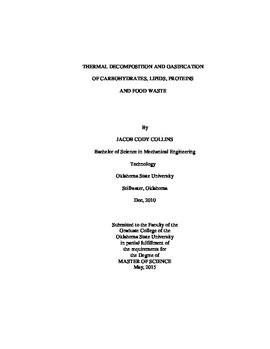| dc.description.abstract | The overall goal of this research was to investigate thermal decomposition of components of food and how food composition affects gasification performance. The specific objectives were to (1) investigate the thermal devolatilization properties of different types of the main components of food (carbohydrates, proteins, and fats), (2) investigate the products of pyrolysis from the components of food (carbohydrates, proteins, and fats), and (3) investigate the effect of food composition on gasification performance. The reaction kinetics of thermal devolatilization of the three types of each food component was investigated in a thermogravometric analyzer and pyrolysis products were investigated using a pyroprobe connected to a gas chromatograph. The devolatilization kinetics parameters were evaluated based on the Arrhenius equation. All types of carbohydrates and proteins devolatilized and had 90 % conversion into pyrolysis products at 600 �C, however, the lipids primarily converted into vapor form and did not decompose. Pyrolysis products of carbohydrates were largely composed of furan and sugar based compounds, whereas those of protein varied depending on the type of protein. Since lipids mainly vaporized, only slight conversion (less than 1 %) into different lipid types and hydrocarbons was observed. One model compound of each type of the food component (dextrose, phenylalanine, and palmitic acid for carbohydrate, protein, and fat) and three food samples with one dominant component were gasified in an updraft gasifier at a gasification temperature of 800�C. The effect of the three main components (carbohydrates, proteins, and fats) in food on gasification performance of syngas yield, composition, carbon conversion efficiency, and cold gas efficiency was evaluated. . Carbon conversion efficiency (CCE) was the highest for carbohydrates, followed by fats, and the lowest conversion for proteins. Cold gas efficiency (CGE) was the highest for fats, followed by proteins, and the lowest efficiency for carbohydrates. No significant effects of food component were observed for the production of H2, CO, and CO2. | |
